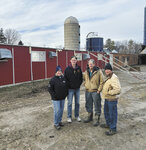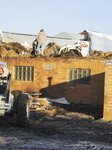



ST. PETER, Minn. — For the Annexstad family, the despair that came when their dairy barn was destroyed by fire Dec. 5 was quickly replaced with gratitude when a rush of community support fol-lowed, especially from fellow dairy farmers.
Matthias Annexstad woke just after midnight at the family’s farm near St. Peter to the sound of people pounding on the door.
“I wasn’t really all the way awake yet, so I walked out on the porch, and sure enough, the barn was on fire,” Matthias said. “They were already on the phone with the fire station at that point. I ran to see if the fire was spreading.”
Matthias’ parents, Rolf and Jean Annexstad, and his uncle, Mike Annexstad, own Annexstad Dairy. Matthias works with them full time. The farm’s milking herd consists of 180 cows, and the family raises youngstock.
Rolf said the barn that caught fire was fortunately not housing cows.
“We have the milking parlor and holding area in our old barn (that burned), and the milk cows are in a separate barn about 300 feet away from the milking facility,” Rolf said. “The fire started in the haymow of the older part of the barn. There are some loafing sheds attached to this old barn with dry cows and youngstock, but the fire never spread to that part.”
Four fire departments responded to the blaze.
“It was pretty quick that emergency and fire crews were showing up, and we assessed what was burning,” Rolf said. “We had a barn office attached to the old barn that was burning, and the fire personnel said we could run in there and grab some things, so we grabbed our computer and some file drawers.”
Then the family’s focus began to change.
“Our focus (at first) was on what we could do to help the fire crew, like answer questions about electrical and gas and so forth,” Rolf said. “Then, sometime in the middle of the night, we started talking about how we were going to get cows milked in the morning.”
By then, Rolf and Jean’s other son, Leif, arrived to help. Their daughter and son-in-law, Emily and Anthony Bosch, came too. The family began reaching out to the dairy-farming community.
“Matthias started making phone calls at 2 in the morning, and we had offers from a few other dairy farm neighbors we had, but there’s not much for dairy down here,” Mike said. “I made a phone call to a friend of mine in Baldwin, Wisconsin, and he could take a few. We found a farm down by Worthing-ton that could take a bunch, and by the time we were all said and done, we had cows going to six farms between Worthington and Baldwin.”
One farm took 80 first-lactation cows, and the nearest farm, which has pack housing, took the special needs cows.
“We are very fortunate that so many people in the dairy community were able to help us out,” Jean said. “It is just remarkable.”
By the early afternoon Dec. 5, the migration of the Annexstads’ 180 cows began.
“The first (truck) was here by 11 a.m.,” Mike said. “Neighbors stopped in at dawn and asked if we needed trailers. When we finally were figuring out where the cows would go, we called these people, and they were lined up by the barn to start loading between noon and 1 p.m.”
Jean said people showed up to help in other ways as well.
“A huge number of people who were great with cows came and helped with the sorting and loading,” she said.
Fortunately, the fire had been put out by then.
“The fire trucks were gone before the cattle got moved,” Rolf said. “The cows were ready to be milked and were all standing by the end of the barn yelling at us, so they were very easy to load. We just opened the gates and they came.”
By midafternoon, the Annexstads turned to gathering necessary data about their cows that they could share with the foster farms.
“Leif and I sorted cows on DairyComp and made lists with basic info to get to the farmers,” Matthias said. “Then, within the last week, we have been working with each of the barns … so that they have what they need to know how to manage them.”
With the cows safely moved to new locations, the Annexstads faced a decision.
“At this point, we felt we had two choices — either sell the cows or rebuild as fast as we can,” Mike said. “Rolf and Jean’s kids were here, and we asked them if we should sell the cows. It took them about one second to say no, so we are starting to rebuild this week.”
The first step is to rebuild the barn’s roof structure. The block, concrete and aluminum roof were built by Mike and Rolf’s uncle in 1948. Their parents moved the family to the farm in 1959. At that time, the barn had tie stalls for milking.
For the rebuild, Rolf said some equipment and parts of the barn might be salvageable.
“The stalls themselves look useable, and the stainless-steel pipes all look fine,” Rolf said. “We don’t know if any of the electronics will be useable because of water.”
The barn’s sturdiness made the damage less severe.
“The damage to the holding pen was only the haymow area, which had a concrete floor, so the fire didn’t do any damage below the concrete and there was still a ceiling on that barn,” Mike said.
Jean agreed.
“During the cleanup, they were actually driving on top of the concrete, pushing off the smoldering hay and straw that was stored up there,” Jean said. “We are not 100% sure we can reinstall and use our milking equipment.”
Mike said the hope is for everything to be functional by Feb. 1, 2024.
Rolf, Jean and Mike have dry cows and youngstock on the farm to care for, and they spend other time with the construction crew. Matthias, with help from Leif, takes care of cow management by keeping in contact with the farms housing the cows. About 125 cows are split between the sites at Worthing-ton and Baldwin; the rest are at farms in Waverly, Sleepy Eye, New Ulm and St. Peter.
The Annexstads finally have time to reflect on all that happened Dec. 5.
“We were overwhelmed with all the help we had, and we will never be able to adequately thank those people for the help they have given us,” Rolf said.
Mike said he is in awe of the number of people who came to help.
“We had friends and neighbors showing up at 2 in the morning, wondering what they could do, and (during the day) on Tuesday, there must have been 40 to 50 people who came,” he said. “The support from everybody has been very touching, humbling and unbelievable.”
For now, the family is adjusting to a farm without a milking herd.
“When I am finishing feeding calves at night and there are no parlor noises or the commotion I am used to going on, that is when it all hits me,” Jean said.
Mark Klaphake contributed to this article.
Comments
No comments on this item Please log in to comment by clicking here